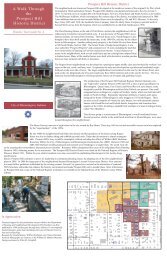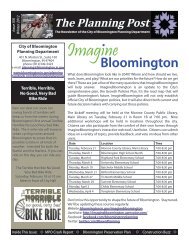Peak Oil Task Force Report - City of Bloomington - State of Indiana
Peak Oil Task Force Report - City of Bloomington - State of Indiana
Peak Oil Task Force Report - City of Bloomington - State of Indiana
Create successful ePaper yourself
Turn your PDF publications into a flip-book with our unique Google optimized e-Paper software.
To that end, we recommend that:<br />
• The <strong>City</strong>, in cooperation with other local entities like Transition <strong>Bloomington</strong>, the<br />
<strong>City</strong> <strong>of</strong> <strong>Bloomington</strong> Commission on Sustainability, the Center for Sustainable Living,<br />
and others, encourage, promote, and support Transition training for all 55 Natural<br />
Neighborhoods (Map D, p. 101) within the next five years. As discussed in the<br />
Economic Context chapter <strong>of</strong> this <strong>Report</strong>, the Transition Movement, motivated by the<br />
twin challenges <strong>of</strong> climate change and peak oil, aims to organize citizens at<br />
neighborhood and community levels around sustainable living.<br />
• The <strong>City</strong> staff stay in contact with neighborhoods as they engage in Transition<br />
projects and assist them in formulating changes to land use regulations that help<br />
them achieve their Transition goals.<br />
• The <strong>City</strong> promptly implement changes as they are proposed by neighborhoods,<br />
amending existing codes where needed.<br />
• If neighborhoods differ greatly with respect to the changes they are willing to<br />
undertake, the <strong>City</strong> Council should consider neighborhood‐specific codes (or<br />
neighborhood‐specific waivers <strong>of</strong> current codes) so as to not impede progress in<br />
neighborhoods that are willing to be more bold than others. Those neighborhoods<br />
could become models for others, and pave the way for more widespread<br />
acceptance <strong>of</strong> changes in local codes. (See also the Land Use chapter’s<br />
recommendation for a pilot nodal overlay to the UDO).<br />
5. Work toward a Unified Comprehensive Land Use and Transportation Plan<br />
As we revise the use <strong>of</strong> the existing built environment, we must simultaneously plan for the<br />
shape <strong>of</strong> the future built environment. In a post‐peak era, we should be aiming for<br />
development patterns that lead to higher population density in areas designated as activity<br />
nodes, and that foster mixed use, walking, biking and transit use. (See Land Use chapter).<br />
Right now, transportation planning is largely separate from land use planning and IU,<br />
Monroe County and the <strong>City</strong> <strong>of</strong> <strong>Bloomington</strong> all draft and implement their plans<br />
independent <strong>of</strong> each other. Within the next five years, the <strong>City</strong>, County and IU should work<br />
with each other and with neighborhood‐based Transition groups to establish a coordinated<br />
planning process that will result in a county‐wide, unified and comprehensive Land Use and<br />
Transportation Plan.<br />
<strong>Report</strong> <strong>of</strong> the <strong>Bloomington</strong> <strong>Peak</strong> <strong>Oil</strong> <strong>Task</strong> <strong>Force</strong><br />
141









